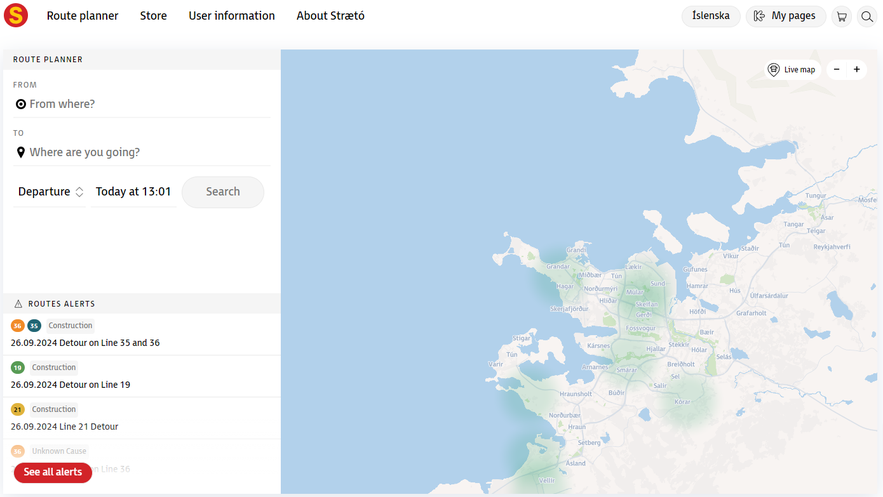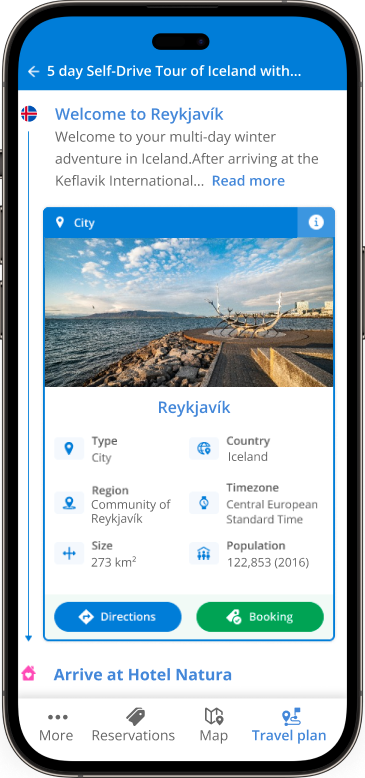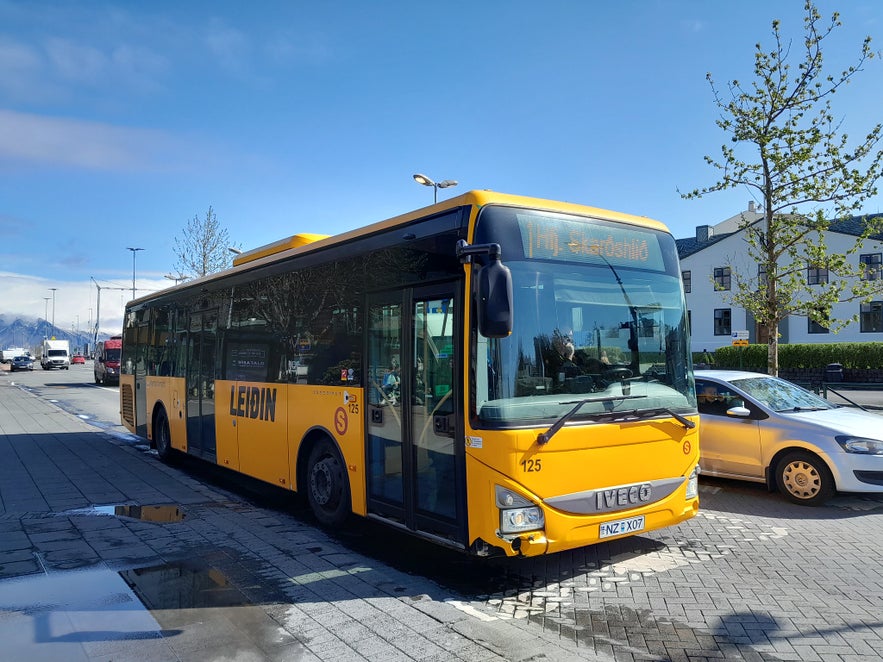
Reykjavik’s city buses offer an easy and reliable way to get around. Learn how to use them efficiently with this guide. Keep reading to discover tips and tricks for a smooth journey through Iceland’s capital.
The Straeto bus system is the only form of public transportation in Reykjavik. The Straeto network operates 27 bus routes throughout the Capital Region, making it easy to find a stop near key landmarks or accommodations in Reykjavik.
Why You Can Trust Our Content
Guide to Iceland is the most trusted travel platform in Iceland, helping millions of visitors each year. All our content is written and reviewed by local experts who are deeply familiar with Iceland. You can count on us for accurate, up-to-date, and trustworthy travel advice.
Straeto operates buses to various towns and some main attractions in the countryside, providing a budget-friendly option. However, transportation options within these areas are limited once you arrive.
For a stress-free experience, consider booking day tours, multi-day packages, or airport transfers, which cover Iceland’s highlights without the need to rent a car.
If Reykjavik is your base, public transport offers a convenient and eco-friendly way to get around. Below, you'll find everything you need to confidently navigate Reykjavik’s bus system, from buying tickets to planning routes on the Straeto website.
Photo above from Flickr, by 7beachbum. No edits made.
Key Takeaways
-
Straeto buses provide a reliable way to get around the city, with routes covering major attractions and neighborhoods.
-
You can pay for bus fares using the Straeto app, bus cards, or contactless credit cards.
-
While taxis and rental cars offer flexibility, they can be expensive compared to public transport and guided tours.
-
Guided tours provide convenient and informative options for those who want to experience Reykjavik and Iceland’s top attractions without navigating public transport.
- Discover the Secret Spots and Hidden Gems in Reykjavik
- Learn more from The Ultimate Guide to Transportation in Iceland
When Can I Get the Bus in Reykjavik?
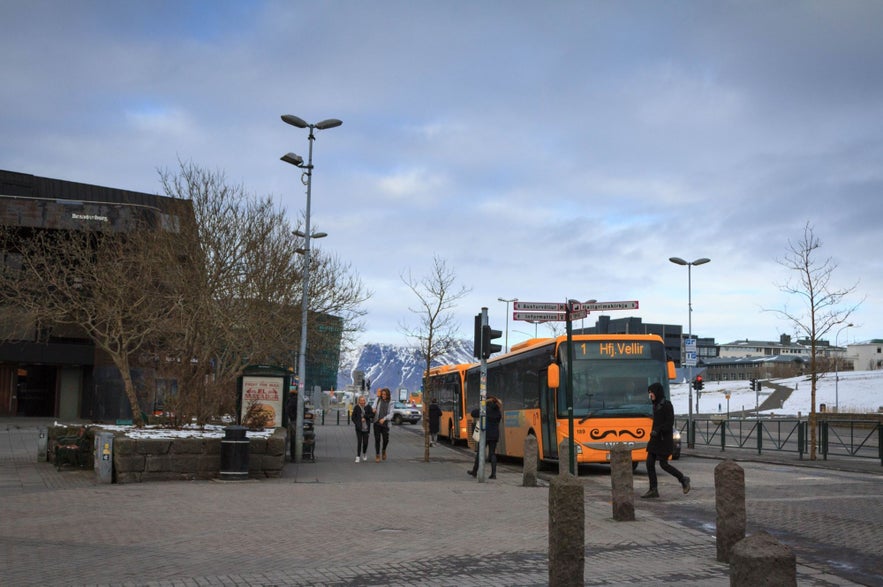
Photo from Wikimedia, Creative Commons, by Gary J. Wood. The bus stop by Laekjartorg Square in downtown Reykjavik.
The Reykjavik bus system starts running around 6:30 PM on weekdays, 7:30 AM on Saturdays, and 9:30 PM on Sundays and public holidays.
Most routes in Reykjavik stop running around midnight, with the exception of the night bus routes, which run on Fridays and Saturdays.
To find out which bus you need to catch, you can use the Straeto website’s handy bus route planner or the "Klappid" Straeto app. You can also see the live location of all buses and the timetables for each bus route.
The Reykjavik bus route planner on the Straeto website.
To use the route planner, just add the location you’ll be departing from, your destination, and your preferred departure or arrival time. The route planner will then show you several options to reach your destination.
The timetables show what time of day the buses stop at specific locations. Detailed information on individual schedules can be seen at each bus stop and searched on the Straeto website.
Most routes have buses running at least every half-hour, with the main buses departing every 15 minutes. Journeys are more frequent during peak hours, between 7-9 AM and 3-6 PM on weekdays.
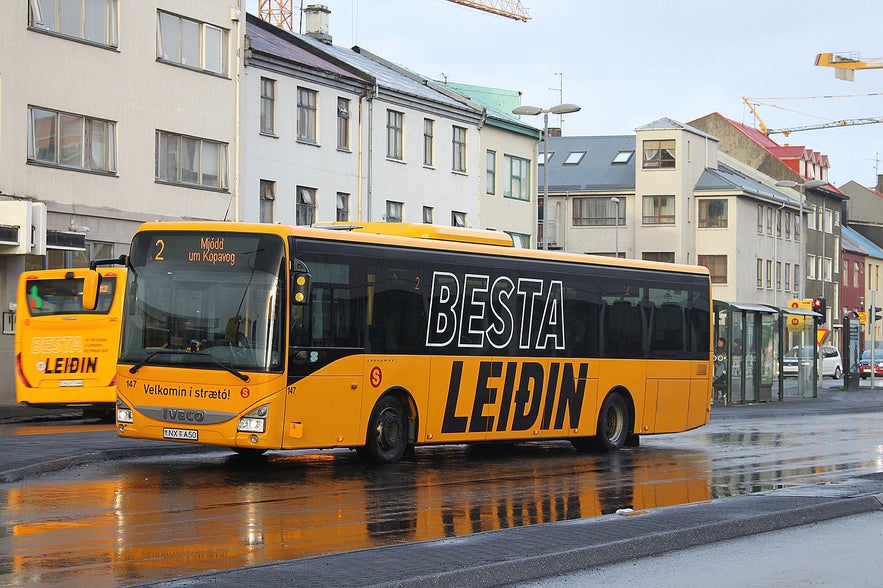
Photo from Wikimedia, Creative Commons, by NAC. No edits made.
Route 1 and Route 6 have more journeys than other routes. On a normal weekday, those buses depart every 10 minutes during peak times, every 15 minutes the rest of the day, and every half hour in the evening.
On public holidays, the buses operate on a Sunday schedule, which has fewer trips per day. The following days of the year also have unusual operating hours:
-
Jan. 1 and Dec. 25: The buses that drive from Reykjavik to the countryside don’t run.
-
Dec. 24 and Dec. 31: The buses stop running at 3 PM.
How Do I Use the Klappid App?
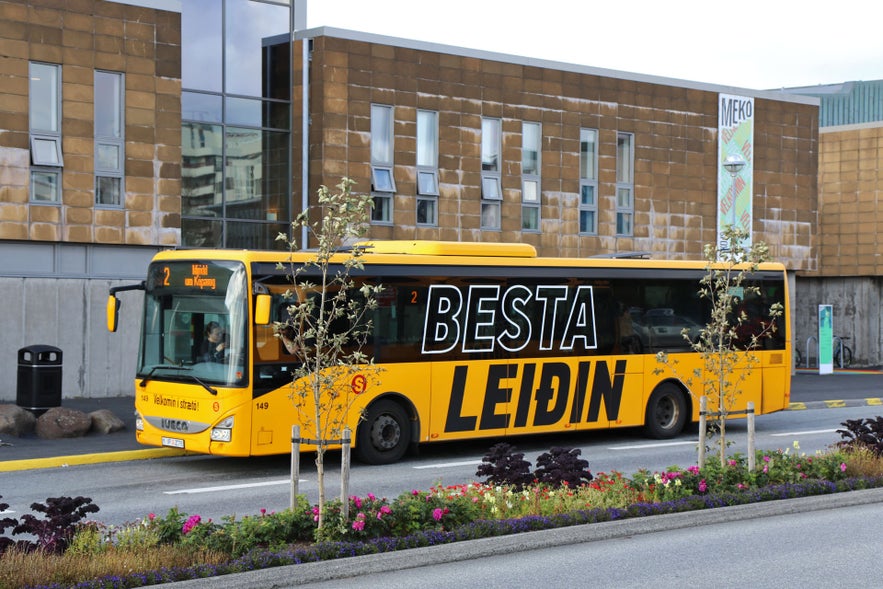
Photo from Straeto. The Hamraborg bus stop by the Library of Kopavogur, where you can get physical Klappid bus cards.
The Klappid app is available in the App Store for Apple devices and on Google Play for Android devices. You can also set it to either Icelandic or English.
Note that you need an internet connection to buy and use tickets from the app. Most buses in Reykjavik have free Wi-Fi, but it’s better to purchase tickets beforehand in case of a bad connection.
The Klappid app is a convenient way to use Reykjavik public transport. The app allows you to buy tickets, plan routes, and view real-time updates of your bus’ location.
To use the app, you simply download it, register with your phone number and card details (the app does not accept American Express), purchase a ticket or card, and you can start using the Reykjavik bus system.
Tickets aren't automatically activated, so you can buy and save them for later. They will remain available under the "My Tickets" section in the app. Once activated, a single-fare ticket is valid for 75 minutes.
When you enter the bus, have your ticket or card ready to be scanned. To your right, you'll see a screen where you can scan the QR code of your ticket. The screen will turn green when it's accepted, and you can go find your seat!
Where Can I Get the Bus in Reykjavik?
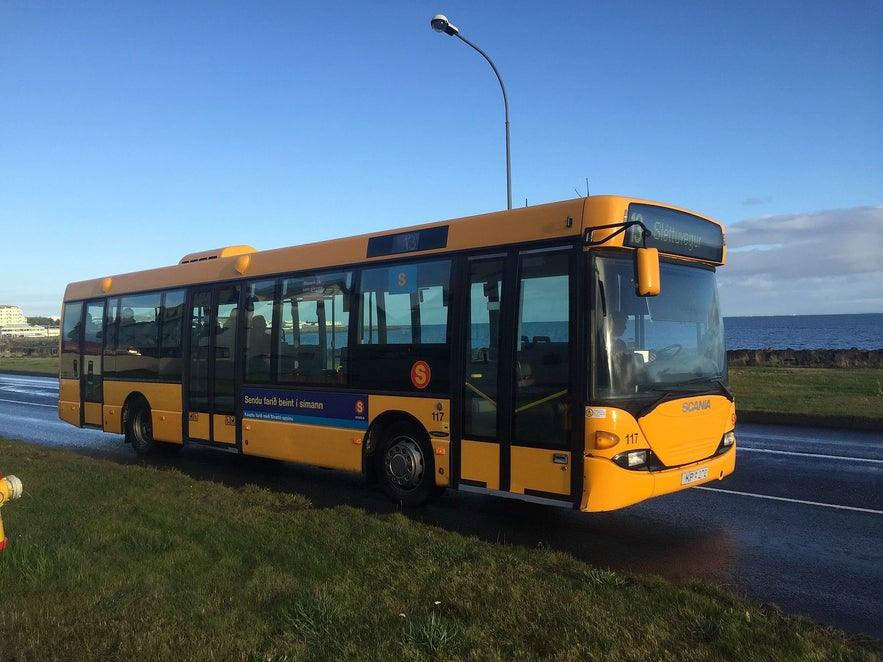
Photo from Wikimedia, Creative Commons, by Richard Eriksson. No edits made.
Straeto bus stops are easy to identify. They are all marked with the Straeto BS logo, a red circle with a yellow "S". Some bus stops are only a pole with the logo on top and timetables attached, while others have a shelter for you to wait in.
To find the nearest bus stop, you can search on the Straeto website or check the live Reykjavik bus map in the Straeto app. It also allows you to track the location of all Straeto bus systems in Reykjavik.
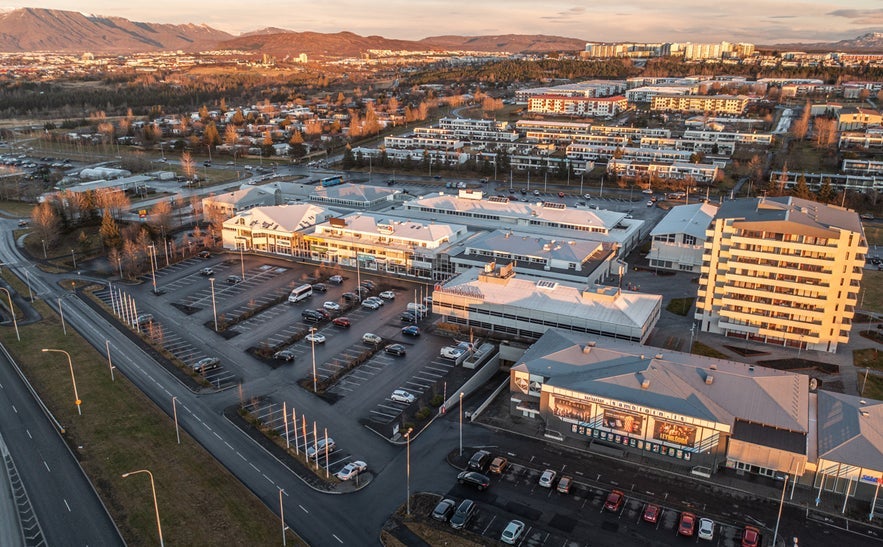
Photo from Mjodd website. No edits made. The Mjodd service center connects many Reykjavik bus lines.
You might have to switch businesses to get where you need to go. The Capital Region (Reykjavik and surrounding areas) has several bus stops specifically designed to connect routes from across the bus network for easy transfer.
These stops are Fjordur, Asgardur, Hamraborg, Mjodd, and Artun. The journeys are planned so that buses arrive at the same time, making it easy for commuters to switch buses.
The bus stops, Hlemmur, Spongin, and Haholt, are also connection stops, but waiting times might be longer since their timetables aren’t specifically designed for smooth transfers.
The stop which connects the city buses and the buses heading outside the Capital Region is Mjodd, in the Breidholt neighborhood in Reykjavik.
How Much Does a Reykjavik Bus Ticket Cost?
As of winter 2025, the fare for one adult is 670 ISK (4.77 USD). For pensioners and children aged 12-17, the fare is 335 ISK (2.39 USD).
Those with a disability can get the bus fare for 200 ISK (1.43 USD), but only by purchasing through the Klappid app. Children under 11 years old don’t have to pay to ride the bus.
For those using contactless payments, Straeto offers a fare-capping system called Kapp, ensuring that adult passengers never pay more than the cost of three rides per day or nine per week. To take advantage of this, passengers must use the same payment card or device for each ride.
To check the current price of fares, check out the Straeto price list on their website.
- Check out How To Travel Around Iceland Without a Car
- See also Where To Eat in Reykjavik: 12 Spots for Dining on a Budget
How Do I Pay for the Bus in Reykjavik?
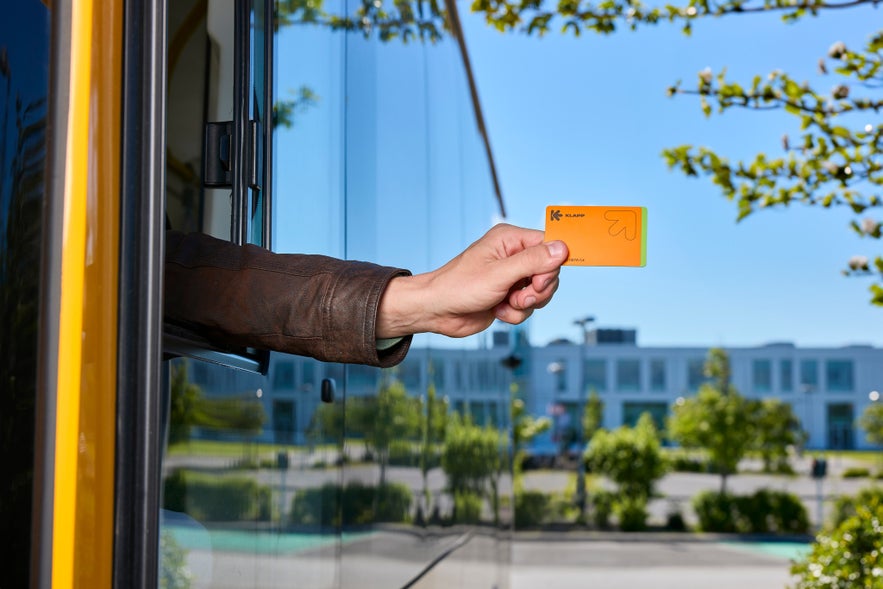
Photo from Straeto. The Klappid bus card.
There are four ways to pay for the bus in Reykjavik: A reusable or paper Klappid bus card, the Klappid App, or contactless card payments.
You can buy a physical Klappid card at various Klappid vendors throughout the city.
Choose from either a plastic bus card that you can refill on the Klappid app or a paper card that lasts for either 24 hours or 72 hours with 10 uses. You can then check the balance of your 10-trip card online.

Klappid payment methods.
You can also use a bus smart card to ride the bus. These cards are in the Klappid app and are the best option for those staying in Reykjavik for a longer stretch of time.
You can buy a card that lasts 24 hours, 72 hours, 30 days, or a whole year. Open it on your smartphone and scan it when entering the bus to verify the ticket.
You can also pay via contactless card payments or via a device/phone using Apple Pay or Google Pay.
How To Take the Bus From and To Keflavik Airport
Taking the public bus to Keflavik International Airport is the most budget-friendly option, though it requires some planning. Bus 55, operated by Straeto, runs between Reykjavik and the airport, but the journey takes longer than a direct airport transfer due to multiple stops along the way.
The bus is most convenient for travelers with minimal luggage and can be boarded at key locations like the BSI bus terminal or Fjordur bus stop in Hafnarfjordur. You can pay for your ticket with a card that has a PIN, but cash payments require exact change, as drivers do not provide change.
If you plan to take Bus 55, it's best to track its schedule using the Klappid app, as it does not always stop automatically at smaller locations.
When taking the bus to Reykjavik from Keflavik Airport, be aware that the bus stop is a short walk from the terminal. It's not clearly marked, but you can find the airport bus location here on Google Maps.
The ride itself is affordable but takes about 20–30 minutes longer than a standard airport transfer. To avoid travel delays, it's wise to plan your journey in advance and allow plenty of time before your flight.
How To Use the Bus To Get to the Blue Lagoon?
To use the Icelandic bus system to get to the Blue Lagoon, you cannot rely solely on public buses like Straeto, as there isn’t a direct route. Instead, you can book various Blue Lagoon tours with transportation included, making it easy and convenient to visit this iconic geothermal spa.
These transfers typically run between Reykjavik, Keflavik International Airport, and the Blue Lagoon. You can book tickets online, and the bus times coordinate with common flight arrivals and departures, making it a convenient option for travelers.
Popular options include the Blue Lagoon admission with transfers from Reykjavik or the transfer and admission from Keflavik Airport, which is ideal for those heading to the lagoon right after landing.
For travelers seeking a straightforward transfer, the one-way transfer from Reykjavik to the Blue Lagoon and the one-way transfer from the Blue Lagoon to Reykjavik are great options.
These services ensure a seamless journey to and from the Blue Lagoon, perfect for those who want to relax without worrying about logistics.
Can I Use Public Transport at Night in Reykjavik?

Straeto runs a very limited night bus service late on the nights before Saturday and Sunday when Reykjavik’s vibrant nightlife is at its height. These are mostly useful if you're staying somewhere outside Reykjavik but well worth keeping in mind.
There are five routes: 101, 103, 104, 105, and 106. Each one has three departure times between 1:20 AM and 3:45 AM, different for each route.
These night bus routes start at either Laekjatorg Square or Laugavegur Street and go to different areas of the Capital Region. No buses run toward the city center after midnight.
The night buses don't make scheduled stops, so watch the live timing in the Klappid app and wave to the driver when you see the bus approaching.
You can find more details about the night bus schedule on the Straeto website. The night bus fare is 670 ISK (4.77 USD) as of winter 2025. You can pay with cash or with a special night bus ticket in the Klappid app. If you have a 30-day or one-year card, it's also valid.
- Check out the Reykjavik Nightlife Guide
- Discover the Best Bars in Reykjavik: The Ultimate Guide
Reykjavik Bus Etiquette
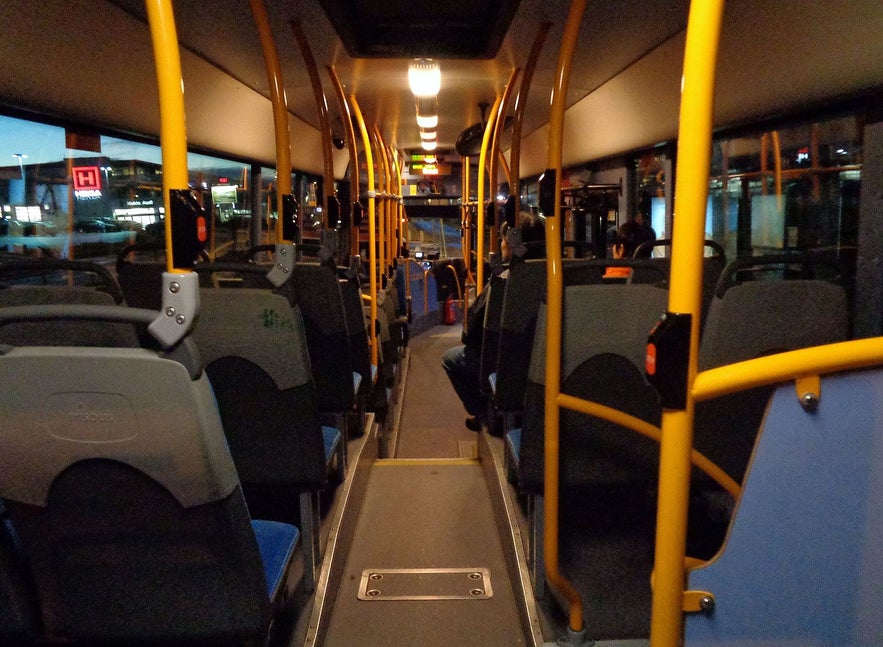
Photo from Wikimedia, Creative Commons, by Otto Karikoski.
You can only get on and off the Straeto bus at designated stops. Make sure to stand outside the bus stop and be ready to go as soon as you see the bus, clearly indicating your intention to board. You can also stick your hand out to flag down the bus if you want to be sure. If you're not paying attention or are still inside the bus shelter, the driver may think you're not going to board and simply drive past you.
If a bus displays the text "Er ekki á leið," it means the bus is not in service.
Unless you have a bicycle, have a baby carriage, are in a wheelchair, or have another reason to enter in the middle of the bus, you should always enter through the front doors. You should have your payment ready before boarding the bus.
You are not allowed to exit at the front of the bus. Instead, use one of the two rear doors. Iceland can be very slippery, so take care when stepping off the bus.
You are allowed to bring bicycles and suitcases on the bus, but know that wheelchairs and baby prams are prioritized in the open designated area in the middle of the bus.
There is space for one wheelchair on each bus, and there is a foldable ramp by the middle exit. If you're a wheelchair user, know that drivers only assist with opening and closing the ramp itself, but you'll have to secure your chair yourself or have someone with you who can help.

Photo from Wikimedia, Creative Commons, by Smiley.toerist.
Please note that although many do, drivers are not required to speak English and might not be able to provide you with detailed information. It's best to use the route planner and online resources to find the information you need before your journey.
Scooters, rollerblades, and skateboards must be carried if you bring them on the bus, and, unsurprisingly, they cannot be used during the ride.
Pets are allowed on city buses under the following conditions. Pets have to get on the bus through the back sets of doors and stay at the back while they ride the bus. The pet’s caretaker must be over 18 years of age to be allowed to bring the pet on the bus, and each person is only allowed to bring one pet. Dogs must be on a lead; other pets must be secured in a cage.
Pets are allowed on the bus except during the busiest times of day, so on weekdays, between 7 and 9 AM and 3 and 6 PM. Trained guide dogs are exempt from these rules and are always allowed.
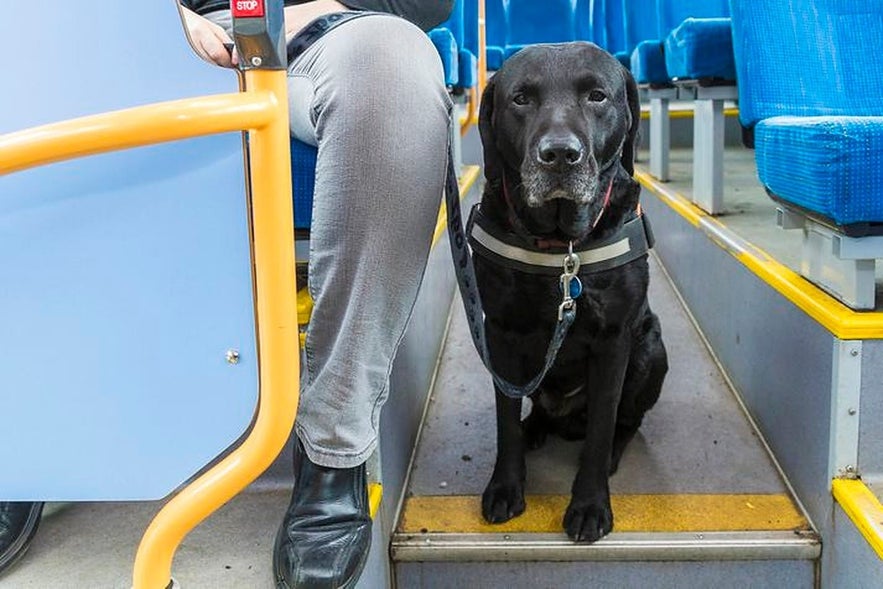
Photo from Straeto/visir.is.
Be mindful of other passengers; there are priority seats for those less able to stand. If you sit in one of those, be ready to offer it to someone who needs it more. Please note that Icelanders are usually quiet on the bus (unless you happen to encounter a group of pre-school children on a field trip). Do not disturb the peace by playing music without headphones on the bus. If you're having a phone call on the bus, do not use the speakers on your phone, and try to speak in a quiet manner.
You are not allowed to eat or smoke on the bus in Reykjavik.
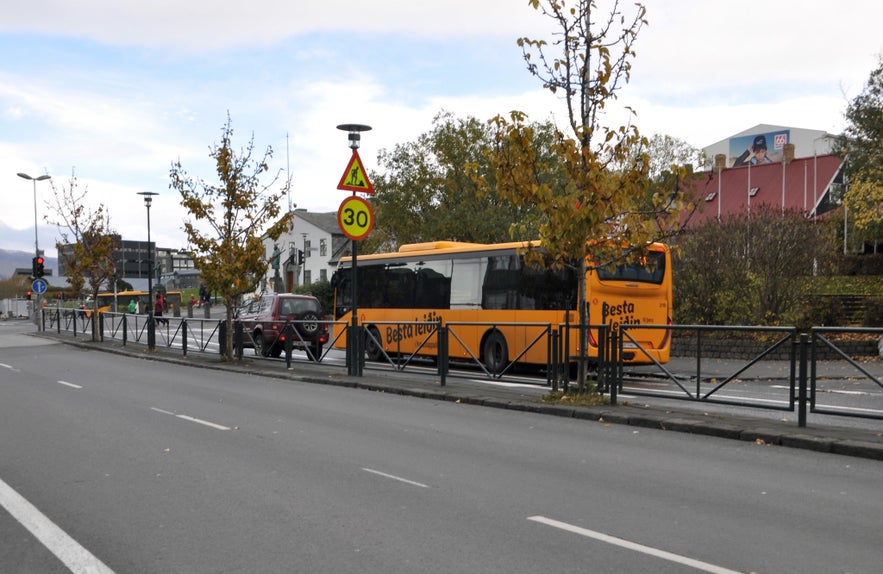
Photo from Flickr, by BeyondDC.
Buses are a convenient way to get around Reykjavik and travel in a more eco-friendly way. Enjoy whizzing around the city in the iconic yellow Straeto buses!
Frequently Asked Questions
Below are answers to common questions travelers ask about getting around Reykjavik.
What is the best way to get around Reykjavik?
The best way to get around Reykjavik is by using public buses (Straeto) or renting a car if you plan to explore beyond the city. To avoid hassle, you can also take guided Iceland bus tours. Taxis and rideshare services are available but can be expensive.
Does Reykjavik have a hop-on hop-off bus?
Yes, Reykjavík has a hop-on hop-off sightseeing bus that stops at major attractions, making it a convenient option for tourists.
How do I pay for Bus 55 in Iceland?
You can pay for Bus 55 with cash (ISK), a contactless credit card, or through the Straeto app, which allows for digital ticket purchases. This is the bus to Keflavik Airport and includes a higher fare.
Is it easy to find parking in Reykjavik?
Finding parking in Reykjavik can be challenging, especially in the city center, but there are designated parking zones with paid meters. Free parking is available in some areas outside the downtown core.
What is the best way to get from Keflavik Airport to Reykjavik?
The best way to get from Keflavik Airport to Reykjavik is by airport shuttle (such as Flybus or Airport Direct), taxi, private transfers, or rental car. Public buses are available but less convenient for travelers with luggage.
Explore Reykjavik and Beyond With Guided Tours
While Reykjavik’s public buses offer a convenient way to explore the city, guided tours provide a hassle-free way to experience both the Capital Region and Iceland’s breathtaking landscapes. Whether you're interested in Golden Circle tours, northern lights excursions, or South Coast tours, joining a tour ensures you make the most of your time without worrying about transportation.
For those who prefer a deeper dive into the city’s culture and history, Reykjavik walking tours, a Reykjavik food walk tour, and sightseeing bus tours are great ways to discover Reykjavik’s highlights.
If you're eager to venture beyond the city, consider this one-week guided winter circle of Iceland tour that takes you to Iceland’s most stunning natural wonders with expert guides. No matter how you choose to explore, there are plenty of options to suit your travel style and itinerary.
Will you use public transport in Iceland? Have you visited Iceland before? Is there anything we missed from this guide? Share your thoughts in the comment section below!

